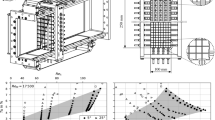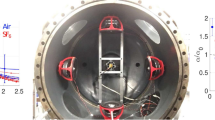Abstract
Experimental turbulent combustion studies require systems that can simulate the turbulence intensities [u′/U 0 ~ 20–30% (Koutmos and McGuirk in Exp Fluids 7(5):344–354, 1989)] and operating conditions of real systems. Furthermore, it is important to have systems where turbulence intensity can be varied independently of mean flow velocity, as quantities such as turbulent flame speed and turbulent flame brush thickness exhibit complex and not yet fully understood dependencies upon both U 0 and u′. Finally, high pressure operation in a highly pre-heated environment requires systems that can be sealed, withstand high gas temperatures, and have remotely variable turbulence intensity that does not require system shut down and disassembly. This paper describes the development and characterization of a variable turbulence generation system for turbulent combustion studies. The system is capable of a wide range of turbulence intensities (10–30%) and turbulent Reynolds numbers (140–2,200) over a range of flow velocities. An important aspect of this system is the ability to vary the turbulence intensity remotely, without changing the mean flow velocity. This system is similar to the turbulence generators described by Videto and Santavicca (Combust Sci Technol 76(1):159–164, 1991) and Coppola and Gomez (Exp Therm Fluid Sci 33(7):1037–1048, 2009), where variable blockage ratio slots are located upstream of a contoured nozzle. Vortical structures from the slots impinge on the walls of the contoured nozzle to produce fine-scale turbulence. The flow field was characterized for two nozzle diameters using three-component Laser Doppler velocimetry (LDV) and hotwire anemometry for mean flow velocities from 4 to 50 m/s. This paper describes the key design features of the system, as well as the variation of mean and RMS velocity, integral length scales, and spectra with nozzle diameter, flow velocity, and turbulence generator blockage ratio.















Similar content being viewed by others
Abbreviations
- A :
-
Nozzle exit area
- E :
-
Power spectral density
- Re D :
-
Geometric Reynolds number
- Re l :
-
Turbulent Reynolds number
- S L :
-
Laminar flame speed
- U(r):
-
Mean axial flow velocity
- U 0 :
-
Spatially averaged flow velocity
- U r(r):
-
Mean radial flow velocity
- U θ(r):
-
Mean azimuthal component of flow velocity
- l :
-
Characteristic longitudinal length scale
- \( \dot{m} \) :
-
Mass flowrate
- u′:
-
RMS of axial velocity fluctuations
- \( u_{\text{tot}}^{\prime } \) :
-
Total turbulence intensity
- u i :
-
Instantaneous axial velocity perturbation
- v′:
-
RMS of radial velocity fluctuations
- w′:
-
RMS of azimuthal component of velocity fluctuations
- Δτ:
-
Time lag width for autocorrelation calculation
- ν:
-
Kinematic viscosity
- ρ:
-
Density
- ρ(τ):
-
Autocorrelation coefficient
- τ:
-
Lag time
- τint :
-
Integral time scale
- τmax :
-
Maximum lag time for autocorrelation calculation
References
Abdel-Gayed R, Al-Khishali K, Bradley D (1984) Turbulent burning velocities and flame straining in explosions. Proc R Soc Lond Ser A Math Phys Sci 391:393–414
Baines W, Peterson E (1951) An investigation of flow through screens. Trans Am Soc Mech Eng 73(1):467–480
Bédat B, Cheng RK (1995) Experimental study of premixed flames in intense isotropic turbulence. Combust Flame 100(3):485–494
Burke M, Qin X, Ju Y, Dryer F (2007) Measurements of hydrogen syngas flame speeds at elevated pressures. In: 5th US combustion meeting, San Diego, p 14
Comte-Bellot G, Corrsin S (1966) The use of a contraction to improve the isotropy of grid-generated turbulence. J Fluid Mech Digit Arch 25(04):657–682. doi:10.1017/S0022112066000338
Coppola G, Gomez A (2009) Experimental investigation on a turbulence generation system with high-blockage plates. Exp Therm Fluid Sci 33(7):1037–1048
Driscoll JF (2008) Turbulent premixed combustion: flamelet structure and its effect on turbulent burning velocities. Prog Energy Combust Sci 34(1):91–134
Kortschik C, Plessing T, Peters N (2004) Laser optical investigation of turbulent transport of temperature ahead of the preheat zone in a premixed flame. Combust Flame 136(1–2):43–50
Koutmos P, McGuirk JJ (1989) Isothermal flow in a gas turbine combustor—a benchmark experimental study. Exp Fluids 7(5):344–354
Liao SY, Jiang DM, Gao J, Huang ZH (2003) Measurements of Markstein numbers and Laminar burning velocities for natural gas–air mixtures. Energy Fuels 18(2):316–326. doi:10.1021/ef034036z
Makita H (1991) Realization of a large-scale turbulence field in a small wind tunnel. Fluid Dyn Res 8(1–4):53–64
Mayo WT Jr (1974) A discussion of limitations and extentions of power spectrum estimation with burst-counter LDV systems. In: International workshop on laser velocimetry, West Lafayette, Indiana, Purdue University, pp 90–101
Mydlarski L, Warhaft Z (1996) On the onset of high-Reynolds-number grid-generated wind tunnel turbulence. J Fluid Mech 320(-1):331–368. doi:10.1017/S0022112096007562
Mydlarski L, Warhaft Z (1998) Passive scalar statistics in high-Péclet-number grid turbulence. J Fluid Mech 358(-1):135–175. doi:10.1017/S0022112097008161
Natarajan J, Lieuwen T, Seitzman J (2007) Laminar flame speeds of H2/CO mixtures: effect of CO2 dilution, preheat temperature, and pressure. Combust Flame 151(1–2):104–119
Prandtl L (1932) Herstellung einwandfreier Luftströme:(Windkanäle)
Shavit U, Chigier N (1996) Development and evaluation of a new turbulence generator for atomization research. Exp Fluids 20(4):291–301
Shepherd IG, Bourguignon E, Michou Y, Gökalp I (1998) The burning rate in turbulent Bunsen flames. Symp (Int) Combust 27(1):909–916
Taylor G (1935) Turbulence in a contracting stream. ZAMM-J Appl Math Mech/Zeitschrift für Angewandte Mathematik und Mechanik 15(1–2):91–96
Tennekes H, Lumley J (1972) A first course in turbulence. The MIT press, Cambridge
Thole K, Bogard D, Whan-Tong J (1994) Generating high freestream turbulence levels. Exp Fluids 17(6):375–380
Tummers MJ, Passchier DM (1996) Spectral estimation using a variable window and the slotting technique with local normalization. Meas Sci Technol 7:1541–1546
Videto B, Santavicca D (1991) A turbulent flow system for studying turbulent combustion processes. Combust Sci Technol 76(1):159–164
Author information
Authors and Affiliations
Corresponding author
Rights and permissions
About this article
Cite this article
Marshall, A., Venkateswaran, P., Noble, D. et al. Development and characterization of a variable turbulence generation system. Exp Fluids 51, 611–620 (2011). https://doi.org/10.1007/s00348-011-1082-6
Received:
Revised:
Accepted:
Published:
Issue Date:
DOI: https://doi.org/10.1007/s00348-011-1082-6




